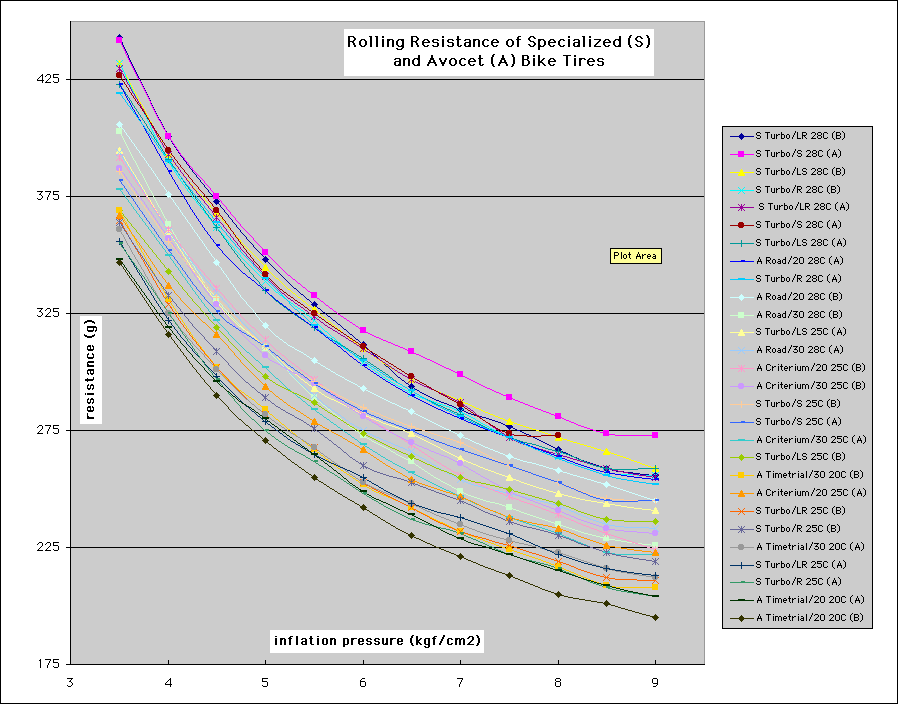tyre pressure
holker
Posts: 88
what difference does tyre pressure make to bike performance? should front and rear tyres be same pressure? what is optimum pressure for performance?
0
Comments
-
As inflation pressure rises: Rolling Resistance gets better, grip gets worse, comfort gets worse. The curve flattens, so practical RR gains are minimal at high pressures, and the cost of poorer grip and comfort aren't worth it.
Also, it depends on tyre size, your weight, and the roads you ride. However, differences are marginal: the total range of pressures that most people prefer is probably 70-120 psi. I'm 12 stone, use 25mm tyres, both at about 100psi. I don't notice if they drop 10psi or so, until I happen to pump them up again.
The practical lower limit is not determined by poor RR (which isn't that bad), but by the likelihood of pinch punctures.0 -
holker wrote:should front and rear tyres be same pressure?
Probably not - as above, it depends upon load and that's something like 40:60 F:R so you can get away with less pressure at the front, giving it a bit more grip which is pretty critical on a bike.ROAD < Scott Foil HMX Di2, Volagi Liscio Di2, Jamis Renegade Elite Di2, Cube Reaction Race > ROUGH0 -
balthazar wrote:As inflation pressure rises: Rolling Resistance gets better, grip gets worse, comfort gets worse. The curve flattens, so practical RR gains are minimal at high pressures, and the cost of poorer grip and comfort aren't worth it.
On non smooth surfaces (such as roads) the curve does more than flatten it drops off quite alarming such that a slightly more inflated tyre will have worse rolling resistence. This is most likely due to bouncing of the wheel which doesn't happen on smooth surfaces or with lower pressures.Jibbering Sports Stuff: http://jibbering.com/sports/0 -
That isn't quite true...
On a perfectly smooth surface, like a velodrome, sure, rr decreases with increased pressure because your contact patch decreases because the tyre deforms less.
However on even slightly uneven surfaces this ceases to be the case as you need enough deformation so that you travel level without your forward momentum being transferred into vertical movement. Hence it is a curve with a peak depending on the surface you're riding on. A great way to really notice this is to pump your tyres up massively, you'll realise that rolling resistance does start to drop above an optimum.
Personally, especially for a fat bloke, i run quite low pressures. 100/110 f/r when on 20mm and 90/100 when on 23s0 -
jibberjim wrote:balthazar wrote:As inflation pressure rises: Rolling Resistance gets better, grip gets worse, comfort gets worse. The curve flattens, so practical RR gains are minimal at high pressures, and the cost of poorer grip and comfort aren't worth it.
On non smooth surfaces (such as roads) the curve does more than flatten it drops off quite alarming such that a slightly more inflated tyre will have worse rolling resistence. This is most likely due to bouncing of the wheel which doesn't happen on smooth surfaces or with lower pressures.
That's received wisdom, and I don't particularly doubt it, but I've never seen a study which measures it. Which test do you have in mind (which presumably resembles that below but curves back upwards at the end)- could you reference it?
All the RR data I've seen has been on a smooth drum. "Lumpy road" is a component which strikes me as impossible to model predictably. However, I don't see why the conclusions from "smooth drum" RR tests will not still hold, all else even. 0
0 -
What is said in theory does not really work in practice - run pressures at their max and you will get a bone-jarring ride, less of your effort turned into forward momentum, and increased risk of falling off when trying to round a bend. Lower pressures can mean a more comfortable ride, more of your effort turned into forward momentum, and you might not even have to slow down as much when going around bends.
But if we are talking a time trial over a smoothish ashphalt surface, or cycling on a track, then pressures close to the max are going to be optimal.
It is an imprecise science.0 -
Schwalbe paid a grad student to do a study, aimed primarily at off-road stuff.
Used a powertap to calculate watts required over many many runs over various surfaces using various tyres and pressures. I cannot find it for the life of me though.0 -
You can get away with a little less front-end pressure, giving it a little more traction, which is important on a bike. Bike tyre pressure is majorly important for cycling performance, including speed, grip, puncture resistance and comfort. If you want a non risk ride, its best to get your tyre pressures right.holker said:what difference does tyre pressure make to bike performance? should front and rear tyres be same pressure? what is optimum pressure for performance?
-3 -
Let's hope the OP is still following this 11 years on from asking the question!vegangeordie said:
You can get away with a little less front-end pressure, giving it a little more traction, which is important on a bike. Bike tyre pressure is majorly important for cycling performance, including speed, grip, puncture resistance and comfort. If you want a non risk ride, its best to get your tyre pressures right.holker said:what difference does tyre pressure make to bike performance? should front and rear tyres be same pressure? what is optimum pressure for performance?
 1
1


